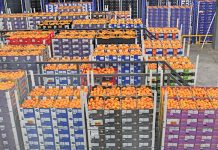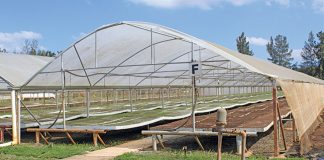
“This is not for the faint-hearted. It’s a helluva thing to get them into spawning condition and keep them happy and healthy.”
So says Guy Musson, technical director of Oceanwise, the East London-based recirculating aquaculture system facility for Dusky Kob (Kabeljou).
But Guy and his business partner, managing director Frans-Johan van Dyk, are undoubtedly succeeding at doing so. Oceanwise is today one of the largest marine-based systems of its type in the world, producing 55t of marketable Dusky Kob (Argyrosomus japonicas) a month. And the pair aims to double this volume within the next five years.
Location and management
Frans-Johan and Guy located Oceanwise in the Eastern Cape mainly due to the reliable sea water supply infrastructure and blanket environmental impact assessments offered in the aquaculture cluster of the East London Industrial Development Zone. The essence of recirculating aquaculture technology (RAS) is to reuse part, or all of the culture water. This involves removing all particulate matter, along with waste ammonia and nitrate by biological filtration, while buffering the pH. The water is oxygenated and aerated, while being kept at optimal temperature.
At Oceanwise, this is between 22°C and 26°C. These conditions allow for excellent feed conversion and growth of Dusky Kob under high stocking densities – and average 50kg/m³ all year round. Ninety percent of the water at Oceanwise is recirculated, helping to minimise the risk of disease entering the system. At the heart of the Oceanwise facility are 34 mature Dusky Kob, 12 of which are female, kept in tanks in a sealed-off hatchery. All these were wild-caught and sourced from Eastern Cape waters, according to permit conditions.

Wild-caught Dusky Kob broodstock in the Oceanwise hatchery. According to Guy Musson, Oceanwise hopes to produce hatchery-reared broodstock in about two years. Click on the link to view the Dusky Kob photo gallery.
Guy explains that they are extremely sensitive about being coerced into an artificial breeding season. “It takes two years to get them settled in and spawning regularly,” he says. When the females spawn (each one produces between 2 million and 12 million eggs at a time) the eggs are fertilised by male fish and then transferred to incubators where they hatch within 48 hours.
The newly hatched larvae are then moved to larval tanks containing filtered, oxygenated, heated and partially circulated water. Here they are fed for three weeks on live feed – cultivated microalgae and enriched zooplankton called rotifers. Later on, they are given artemia, another variety of zooplankton. During this time, they are monitored regularly for morphology and size.
At 18 to 21 days after hatching, the larvae are weaned off live cultures and given dry feed. Between 30 and 35 days, weaned larvae go through a metamorphosis and become fully developed. Once the fingerlings reach an average size of 1,6g they are moved to the grow-out section, where they are fed according to specific feeding charts, temperature calculations and growth rate indicators. The Dusky Kob at Oceanwise can reach a marketable weight of 1kg within 12 to 14 months, depending on temperature and water conditions.
Great potential
Frans-Johan believes there is a positive future for marine finfish aquaculture in South Africa, provided that production costs can be decreased and general productivity increased. “The industry is small here and has a great deal of potential,” he says. “It needs a couple of businesses to become successful and sustainable for the industry to develop.”
The labour-intensive nature of RAS aquaculture, expensive imported feed (landed at R16,50/kg), distances to markets in Gauteng, Durban and Cape Town, and the steeply rising cost of power all contribute to production costs for Oceanwise and help explain why Oceanwise Dusky Kob is on average 20% more expensive than wild-caught Kob.
In particular, the increase in the electricity tariff is of deep concern, and the company is seriously investigating alternative energy sources. “We’re looking at various ways of generating our own electricity, whether through biodigesters, solar power or marine power,” explains Frans-Johan.
Netted by state red tape
A further problem for Oceanwise is that it has found itself at a regulatory disadvantage. “The regulations of certain acts don’t accommodate marine aquaculture,” he explains. “We have to satisfy far more stringent compliance demands than the wild-caught industry – in fact, it’s like chalk and cheese.”
Guy agrees, saying that although legislation regulated by the Department of Agriculture, Forestry and Fisheries is slowly adapting to the needs of aquaculture ventures, current legislation was basically designed for the wild-caught fishing industry.
According to Frans-Johan, fledgling local aquaculture initiatives find it difficult to compete, despite the government’s recently launched R800 million Aquaculture Development and Enhancement Programme (Adep). Although Adep offers significant cost-sharing grants to stimulate development in the industry, a lack of import tariffs on aquaculture products entering the country, especially from the Far East, prejudices local producers.
A unique marine product
Pressure on wild Dusky Kob stocks, 95% of which have disappeared due to commercial exploitation, seems to ensure a good future for marine finfish producers that can offer a regular alternative to wild-caught fish. “From a conservation point of view we really have a viable substitute,” says Frans-Johan. “Demand is increasing all the time and we can supply fresh fish all year round – and do so sustainably.”
Flesh analysis shows that Oceanwise Dusky Kob is free of heavy metals, antibiotics, steroids and growth hormones. Mercury contamination in particular is becoming an increasing problem in the global wild-caught fish industry. Thanks to all these factors, Oceanwise Dusky Kob produced on land has been listed as a ‘Green’ best choice by the SA Sustainable Seafood Initiative.
Another environmental plus is that all feed imported by Oceanwise from Europe is 100% traceable, while Oceanwise itself has installed an in-house system that monitors and tracks all fish movement and integrated production systems for full traceability. The Oceanwise processing facility is also approved by the Food Safety Authority.
Contact Oceanwise on 043 702 8209 or visit www.oceanwise.co.za.













